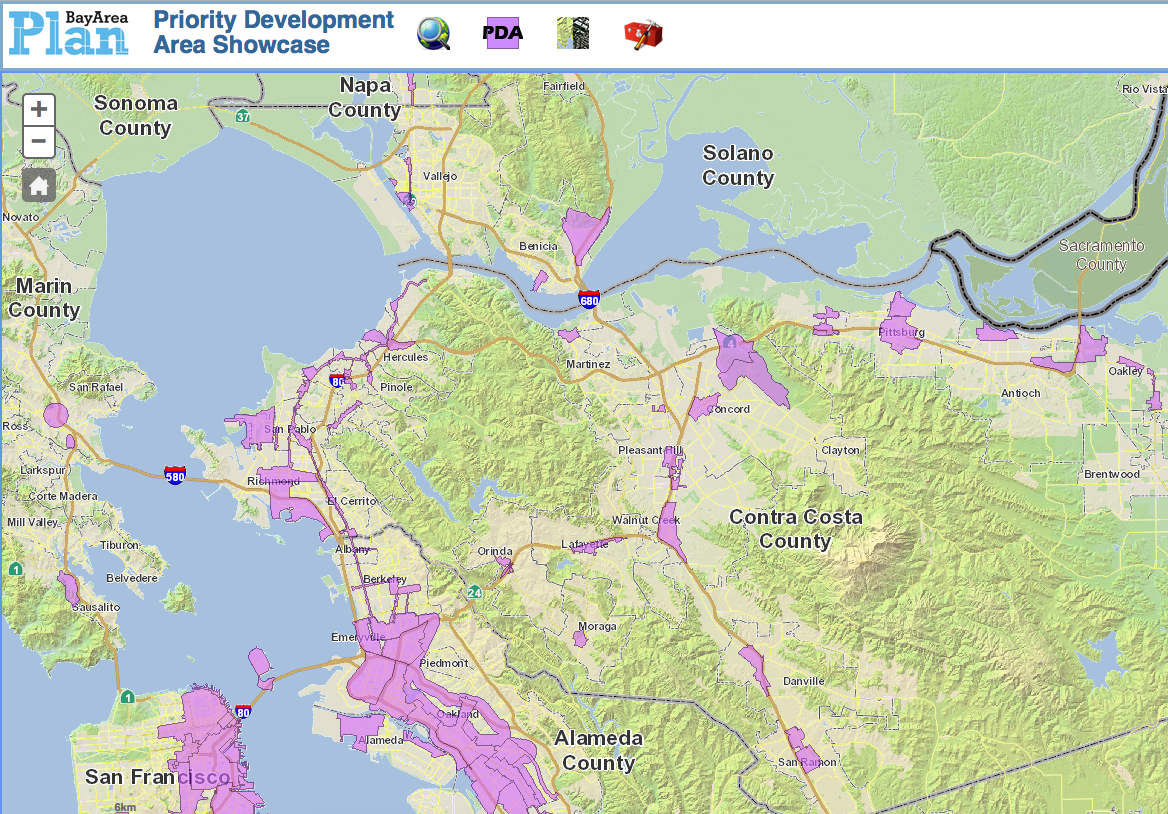By Matt Williams
 Contra Costa and Marin Counties are falling behind on building much-needed transit-friendly housing as part of their planned Priority Development Areas: areas of infill development identified to house most of the 2.3 million new residents expected in the Bay Area by 2040. Unless the counties get moving — and soon — their failure will fuel more displacement of low-income families, and the Bay Area's key strategy for reducing greenhouse gas emissions (GHGs) will be hamstrung.
Contra Costa and Marin Counties are falling behind on building much-needed transit-friendly housing as part of their planned Priority Development Areas: areas of infill development identified to house most of the 2.3 million new residents expected in the Bay Area by 2040. Unless the counties get moving — and soon — their failure will fuel more displacement of low-income families, and the Bay Area's key strategy for reducing greenhouse gas emissions (GHGs) will be hamstrung.
State law requires metropolitan regions including the Bay Area to reduce GHGs from passenger vehicles below the levels achieved by state actions. Since the state is responsible for making cars more fuel-efficient and making gas less carbon-intensive, the best way metropolitan areas can achieve GHG reductions is by cutting down on how many miles their residents drive. Automobiles are the biggest source of GHG emissions in the Bay Area.
The Bay Area’s strategy for achieving the required GHG reductions integrates transportation, housing, and land use (as required by state law). The strategy, known as Plan Bay Area, is focused on Priority Development Areas (PDAs). In theory, PDAs cut down on driving by putting jobs, shops, schools, and homes close together so that people can walk, ride a bike, or take transit to get around. Since more people will be living closer together, there won’t be room for everyone to have a car, so there must be investments in bike lanes, pedestrian roadways, and transit in order to reduce vehicle miles traveled.
Unfortunately, Plan Bay Area didn’t deliver on public transit, city planning, or climate goals, so in 2013 Communities for a Better Environment and the Sierra Club sued the Bay Area’s two regional planning agencies: Metropolitan Transportation Commission and Association of Bay Area Governments. A settlement was worked out and the two agencies agreed to provide an analysis of PDA performance in time for stakeholders to submit comments prior to the plan's 2017 update. The promised analysis was not produced in a timely manner, but some information has now been released. Here’s what we have learned about Contra Costa and Marin’s PDAs:
Contra Costa County
Contra Costa County has 39 PDAs that are supposed to grow by 165,000 residents by the year 2040. However, not all of them are ready to go. In fact, thirteen of the PDAs are categorized as “potential,” which means they are not ready to take on new residents.
Housing is a core element of PDAs, so a key question is whether enough housing is being built to take on the expected number of new residents. Plan Bay Area’s performance target on “adequate housing” is to house 100% of projected growth without displacing current low-income residents.Unfortunately, Contra Costa is not meeting this target.
Twenty-eight of the county’s 39 PDAs produced no affordable housing units in either 2013 or 2014. In all of the 39 PDAs, only 412 housing units were produced during those two years. At this rate, only 5,000 units would be built by 2040, when 165,000 people are supposed to be living in Contra Costa’s PDAs — that’s 33 people per unit!
Contra Costa’s PDAs are lacking in other areas too:
- PDAs are supposed to have adequate open space and parks. Ten of the PDAs have no parks.
- PDAs are supposed to have public-transit service within a quarter-mile that operates at 15-minute intervals during peak commute times. Fifteen of the PDAs do not meet this standard.
- Each PDA should be treating pedestrians, bicyclists, and transit riders as equal to car drivers. A “Complete Streets” policy — designed to enable safe and convenient travel for users of all ages and abilities regardless of their mode of transportation — is needed to make a PDA successful, yet five of the PDAs do not have such a policy in place.
- Six of Contra Costa's PDAs are in areas projected to flood due to sea-level rise.
With housing creation behind schedule and other concerns mounting, Contra Costa County has its work cut out to make its PDAs successful.
Marin County
Marin County has a troubled history with PDAs, and there’s a lot they need to do to make them successful. The number of PDAs in Marin has been cut over the past several years, and now there are only two. One of them is “potential” and does not have a Complete Streets policy in place. Only one has a park, and both are subject to flooding from sea-level rise. No housing units were produced in 2013 or 2014.
The total expected population increase by 2040 in Marin’s two PDAs is just 3,600, so the county might get the necessary housing built if work starts soon. The only other good news is that both PDAs meet transit-service goals.
The Sierra Club wants the Bay Area’s PDAs to be successful. That requires county authorities to be committed to that goal. So far, since Plan Bay Area was adopted in 2013, there has not been much progress. That needs to change, and soon. We cannot wait until December 31, 2049 to meet the state’s 2050 GHG reduction target!